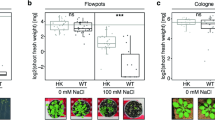Abstract
IT has been thought unlikely that antibiotics are produced under natural conditions, (a) because the necessary nutrients would not usually be available and (b) because other micro-organisms might be expected to compete for nutrients and, in some cases, to destroy metabolically any antibiotic formed. Nevertheless, a plant parasite may have access to a relatively rich nutrient supply and may be, in early stages of an infection at least, isolated from the influence of other micro-organisms. Penicillium expansum is an unspecialized plant parasite, causing storage rots of apples; most freshly isolated strains produce the antibiotic patulin (synonyms : clavacin, expansine) in suitable culture media. We thought it of interest to see whether it produces patulin in apple tissues.
This is a preview of subscription content, access via your institution
Access options
Subscribe to this journal
Receive 51 print issues and online access
$199.00 per year
only $3.90 per issue
Buy this article
- Purchase on Springer Link
- Instant access to full article PDF
Prices may be subject to local taxes which are calculated during checkout
Similar content being viewed by others
References
Lakshminarayan, K., and Subramanian, D., Nature, 176, 697 (1955).
Brian, P. W., Elson, G. W., Hemming, H. G., and Wright, J. M., Ann. App. Biol., 39, 308 (1952).
Author information
Authors and Affiliations
Rights and permissions
About this article
Cite this article
BRIAN, P., ELSON, G. & LOWE, D. Production of Patulin in Apple Fruits by Penicillium expansum. Nature 178, 263–264 (1956). https://doi.org/10.1038/178263b0
Issue Date:
DOI: https://doi.org/10.1038/178263b0
This article is cited by
-
Preparation and characterization of a molecularly imprinted polymer by grafting on silica supports: a selective sorbent for patulin toxin
Analytical and Bioanalytical Chemistry (2011)
-
Potential of patulin production by Penicillium expansum strains on various fruits
Mycotoxin Research (2010)
-
Patulin in Lebensmitteln pflanzlicher Herkunft
Zeitschrift f�r Lebensmittel-Untersuchung und -Forschung (1977)
-
Patulinbestimmung in Lebensmitteln
Zeitschrift f�r Lebensmittel-Untersuchung und -Forschung (1977)
-
Patulin in Lebensmitteln pflanzlicher Herkunft
Zeitschrift f�r Lebensmittel-Untersuchung und -Forschung (1976)
Comments
By submitting a comment you agree to abide by our Terms and Community Guidelines. If you find something abusive or that does not comply with our terms or guidelines please flag it as inappropriate.



